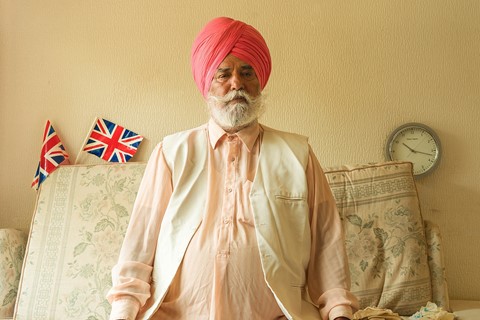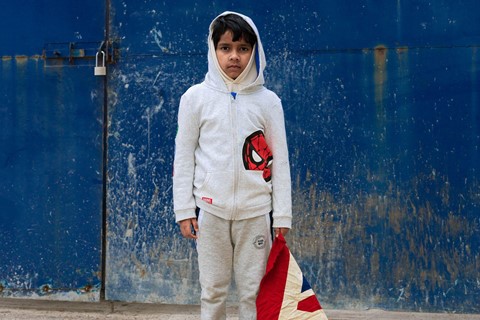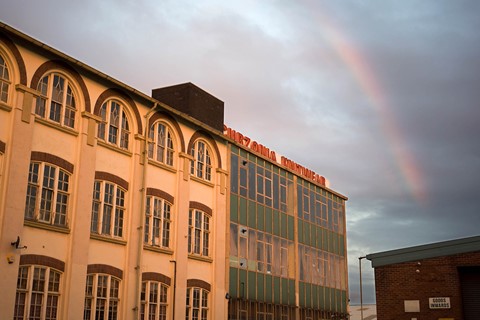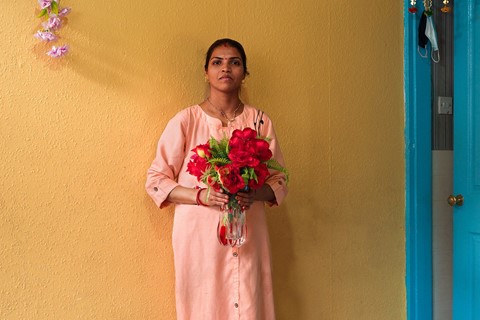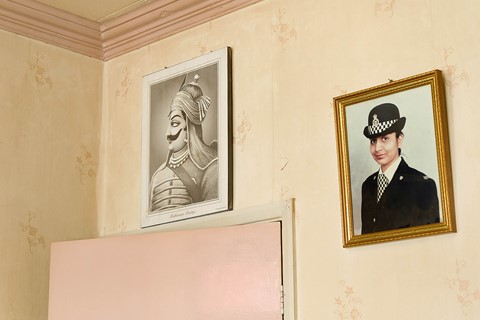As his debut monograph is released, Kavi Pujara talks about his complicated relationship with Leicester’s Golden Mile, being mentored by Martin Parr, and the myth of the British Empire
Working in his dad’s newsagents in the 1980s, Kavi Pujara would pore over photography magazines, mesmerised by the images he’d see. Speaking on Zoom, he holds up a still-pristine old copy, and gushes over the Joel Meyerowitz spread that first inspired him to take photographs. “How on earth does someone go about pulling this off? It seemed unbelievable,” he says. “I just couldn’t figure out how you got yourself into those situations and drew that emotion.”
This week Pujara will release his debut monograph, This Golden Mile – borrowing its name from Leicester’s Golden Mile, it references the one-mile stretch of Melton Road that turns into Belgrave Road – with a corresponding exhibition at Martin Parr Foundation.
Since our call in late August, Leicester’s South Asian community – which Pujara’s work takes great care in documenting – has been in the national and international press following a series of religious confrontations. The clashes, predominantly between Muslim and Hindu men in the east of the city, arrived in the aftermath of the 75th anniversary of Partition, and speak to a wider issue regarding tensions within India’s politics and its influence on diasporic communities. Taking to Instagram in September, where he shared an image of three men, Hindu, Muslim and Sikh, unloading a truck in 2018, Pujara reaffirmed his intentions for the project, as “a love letter to the peaceful & tolerant community I grew up around.”
“It’s complicated,” he said in August, reflecting on his relationship with Leicester’s Golden Mile. A largely multicultural area that hosts the biggest Diwali celebrations outside India, Pujara’s extended family lived close by during his childhood. “It was a different place to what it is now. I remember aunts being careful about hanging laundry, saris and things signalling they were Asian, because people would throw coal dust. So it’s mixed feelings. Reflecting now though, there was a great sense of community and so many family events. You’d know there was a gathering as half the pavement would be covered in people’s shoes.”

Having moved to London at 18, Pujara’s return to Leicester – where he lives today after three decades away – made him something of an outsider, while his early street photography proved a confrontational exercise. He believes that switching to a larger format camera in 2018, one which announced him outright as a photographer in the area, was a game changer. Still, the image-making itself was just a small part of This Golden Mile. “Talking and listening, not necessarily producing photographs, that was the real heart of the project,” he says. “I was [originally] trying to create opportunities to make photographs, but the real gold were these connections. I only recognised that two-thirds [of the way] through.”
A colourful collection of portraits and quiet corners, the work was part-funded by a bursary from the Martin Parr Foundation he received in 2020. More consequential for Pujara however, was the accompanying small print that referenced mentorship opportunities with Parr. “I can’t stress how crucial him being available for me was,” he shares today. “We got to a point where I could show him my rubbish photographs, and he would see stuff I hadn’t.” Similarly invaluable was photographer Kalpesh Lathigra, whose counsel he sought via Instagram during the pandemic.

“I struggled with the idea of representing this community,” continues Pujara, who describes the project as more about his own discoveries. “There’s a diverse range of thought, from one generation to the next, including Brexiteers who’re perhaps not sympathetic to newer generations of migrants from the same community. That was new to me, these waves of migration that happen to a community. Unique to this area was that they were from the same part of India – via India directly in the 1950s and 1960s, East Africa in the late 60s, early 1970s, or Portuguese colonies in the late 2010s, when Gujarati-speaking Indians came to Leicester under their European right to live and work. I started to see patterns, and eventually my parents and grandparents reflected in these stories. That deepened the work.”
In the background of all this, the creation of the Nationality and Borders Bill added a further layer to the project; in contemplating its architects – Priti Patel and Rishi Sunak – Purjara was pushed to examine the source of the confrontation between generations. “I found that really conflicting, but it got me thinking about Britishness. My grandfather came from India to East Africa, his passport said British Indian citizen. My mum was born in Uganda, it said British Ugandan citizen, father from Kenya, British Kenyan citizen – these ideas of Britishness are so ingrained with them. There’s a myth we’re told about empire as a force for good, that my own community has bought into,” he says. “My son learns about the British Empire at school in such a binary way, never about how these structures were put in place as a mechanism to extract wealth. Brexit too, was sold on the British Empire as this benevolent force. It’s just not true – we know this – but the myth still exists.”
This Golden Mile is published by Setanta Books. The work is on display at Martin Parr Foundation in Britsol from 6 October – 18 December 2022.

